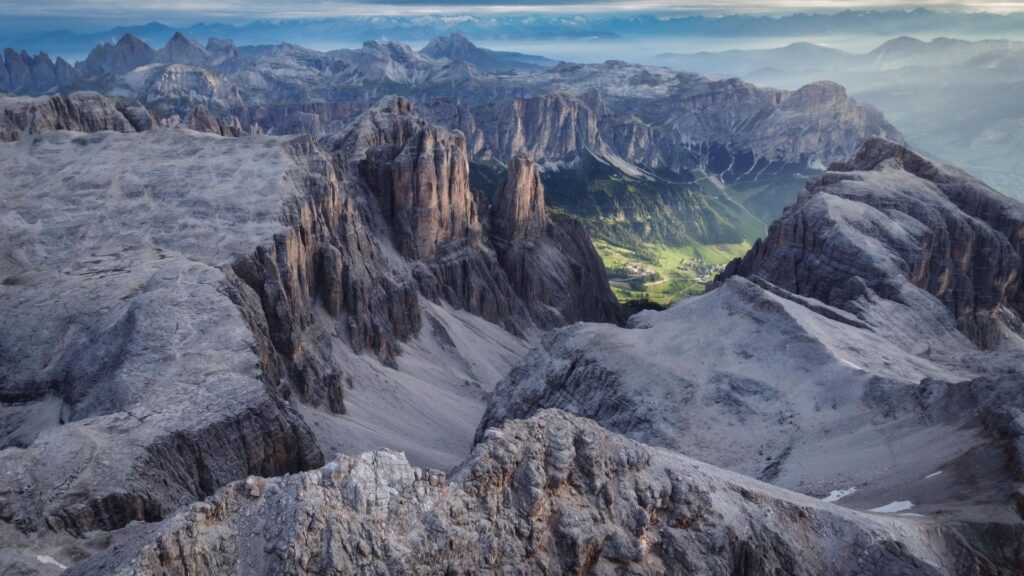Crossing of the Sella Group with Piz Boè: A Journey through the Heart of the Dolomites
The Dolomites, a mountain range in the northern Italian Alps, are renowned for their dramatic peaks, jagged cliffs, and vast plateaus. One of the most iconic and memorable hikes in this region is the crossing of the Sella Group with the ascent of Piz Boè, the highest peak within the Sella massif. This trek offers not only breathtaking views but also an opportunity to immerse yourself in the rich history, geology, and natural beauty of the Dolomites. This article will explore the allure of the Sella Group, the challenge of summiting Piz Boè, and the unforgettable experience of hiking in this UNESCO World Heritage site.
The Sella Group: A Geological Marvel
The Sella Group is a vast, towering limestone plateau that dominates the Dolomites. It is a unique and dramatic massif that rises abruptly from the surrounding valleys, creating a near-vertical wall on all sides. This structure makes the Sella Group look like a natural fortress, an island of rock amidst the rolling hills and lush valleys of the Dolomites.
Geologically, the Sella Group is part of the Dolomite rock formation, which dates back to the Triassic period, approximately 250 million years ago. Over millennia, the forces of nature—glaciation, weathering, and erosion—have shaped the landscape, creating the dramatic cliffs, gorges, and high plateaus that characterize the area today. The rugged beauty of the Sella Group is accentuated by the contrast between the light-colored dolomitic rock and the vibrant green valleys below.
The Sella Group’s height, combined with its relatively flat top, creates a stunning high-altitude plateau that feels like a world unto itself. From the summit, you can see vast stretches of the Dolomites, with views of distant peaks, valleys, and mountain passes. This makes the crossing of the Sella Group a highly sought-after experience for mountaineers, hikers, and nature lovers.
Piz Boè: The Highest Peak in the Sella Group
Standing at 3,152 meters (10,341 feet), Piz Boè is the highest peak in the Sella Group and one of the most popular summits in the Dolomites. While it may not be the tallest mountain in the region, its accessibility, combined with the stunning views it offers, makes it a favorite destination for hikers and climbers alike.
Unlike many other peaks in the Dolomites, Piz Boè is considered relatively easy to climb, even for those with limited mountaineering experience. The most popular route begins from the Pordoi Pass, a high mountain pass at an altitude of 2,239 meters (7,346 feet) that connects the provinces of Trentino and Belluno. From the pass, the hike follows a well-marked trail that gradually ascends the slopes of the mountain.
Despite its relative ease, the climb to Piz Boè is not without challenges. The high altitude, steep sections, and occasional exposure to cliffs require a good level of fitness and caution. However, the effort is well worth it, as the views from the summit are nothing short of spectacular. On a clear day, you can see not only the Dolomites but also the distant Alps, the Marmolada Glacier, and even the Austrian border to the north.
The Route: From Pordoi Pass to Piz Boè
One of the most common starting points for the crossing of the Sella Group and the ascent of Piz Boè is the Pordoi Pass. This high mountain pass is easily accessible by road and is a popular destination for tourists, offering panoramic views of the surrounding mountains. From here, several trails lead into the heart of the Sella Group, with one of the most popular being the route to Piz Boè.
The trail begins at the top of the Pordoi Pass, where hikers can take a cable car to the Sass Pordoi, a viewpoint at an altitude of 2,950 meters (9,678 feet). From Sass Pordoi, the trail continues across the rocky plateau of the Sella Group, gradually ascending toward the summit of Piz Boè.
The first section of the hike is relatively easy, following a well-marked path across the plateau. The terrain is rocky but not too steep, and the views of the surrounding mountains are breathtaking. As you continue, the trail becomes steeper, with several sections requiring some scrambling over rocks. While these sections are not technically difficult, they do require careful footing and a good level of fitness.
After several hours of hiking, you will reach the summit of Piz Boè. Here, you are rewarded with a 360-degree panorama of the Dolomites. The views are awe-inspiring, with jagged peaks, deep valleys, and distant glaciers stretching out in all directions. On a clear day, you can even see the peaks of the Austrian Alps in the distance.
The Descent: Returning to the Pordoi Pass
After soaking in the views from the summit, the descent begins. The most common route is to retrace your steps back to the Pordoi Pass. However, there are several alternative routes that offer a more varied and challenging descent. One popular option is to descend via the Val Lasties, a deep and narrow valley that cuts through the Sella Group. This route is more demanding, with steeper sections and more technical terrain, but it offers a unique and rewarding experience for those looking for an extra challenge.
Another option is to continue across the Sella Group, descending into the Gardena Pass. This route takes you through some of the most scenic parts of the Dolomites, with views of the towering cliffs and peaks of the Sella Group and the surrounding valleys. It is a longer and more demanding hike, but it is also one of the most rewarding ways to experience the beauty of the Dolomites.
What to Bring: Essentials for the Hike
The crossing of the Sella Group and the ascent of Piz Boè is a high-altitude hike that requires proper preparation and equipment. Here are some essentials to bring with you on this adventure:
- Sturdy hiking boots: The rocky and uneven terrain of the Sella Group requires good footwear with ankle support and a sturdy sole.
- Layered clothing: The weather in the Dolomites can change quickly, especially at high altitudes. Bring layers that can be added or removed as needed, including a waterproof jacket in case of rain.
- Sunscreen and sunglasses: The high altitude and exposure to the sun make sunscreen and sunglasses essential, even on cloudy days.
- Water and snacks: There are few places to refill water along the trail, so bring enough for the entire hike. High-energy snacks like trail mix or energy bars are also recommended.
- Map and compass: While the trails in the Dolomites are well-marked, it is always a good idea to carry a map and compass, especially if you plan to take one of the less-traveled routes.
Final Thoughts: A Hike to Remember
The crossing of the Sella Group with the ascent of Piz Boè is one of the most memorable hikes in the Dolomites. From the dramatic cliffs of the Sella Group to the panoramic views from the summit of Piz Boè, this adventure offers a unique and rewarding experience for hikers of all skill levels. Whether you are a seasoned mountaineer or a casual hiker, the beauty and majesty of the Dolomites will leave you with memories that will last a lifetime.


